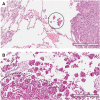Prognostic impact of spread through air spaces in lung adenocarcinoma
- PMID: 34662397
- PMCID: PMC10634402
- DOI: 10.1093/icvts/ivab289
Prognostic impact of spread through air spaces in lung adenocarcinoma
Abstract
Objective: Spread through air spaces (STAS) is a pattern of invasion present in some adenocarcinomas (ADC). The goal of this study was to assess the impact of STAS in patients treated with different types of surgical resections and on the clinical outcome in patients with ADC of different diameters and with different degrees of nodal involvement.
Methods: A total of 109 patients were reviewed. Complete surgical resection with systematic nodal dissection was achieved in all patients. The median follow-up was 65 months (3-90 months).
Results: STAS was observed in 70 cases (64.2%); 13 patients (18.5%) had lymph node involvement (N1 and N2). Overall survival and progression-free survival were higher in patients without STAS (P = 0.042; P = 0.027). The presence of STAS in tumours ≤2 cm was a predictor of worse progression-free survival following sublobar resection compared to major resections (P = 0.011). Sublobar resection of N0 STAS-positive tumours was associated with worse long-term survival compared to a major resection (P = 0.04). Statistical analyses showed that age >70 years and recurrence were independent variables for survival; smoking pack-years >20, sublobar resection and nodal involvement were independent variables for recurrence; and smoking pack-years >20 were independent variables for a history of cancer and pleural invasion for local recurrence.
Conclusions: STAS seems to play a role in long-term survival, particularly for patients with N0 and tumours smaller than 2 cm. Further studies are necessary to validate this hypothesis.
Keywords: Adenocarcinoma; Lymph node involvement; Pulmonary resections; STAS.
© The Author(s) 2021. Published by Oxford University Press on behalf of the European Association for Cardio-Thoracic Surgery.
Figures



References
-
- Travis WD, Brambilla E, Nicholson AG, Yatabe Y, Austin JHM, Beasley MB et al.; WHO Panel. The 2015 WHO classification of lung tumors. Impact of genetic, clinical and radiological advances from 2004. J Thorac Oncol 2015;10:1243–60. - PubMed
-
- Blaauwgeers H, Russell PA, Jones KD, Radonic T, Thunnissen E. Pulmonary loose tumor tissue fragments and spread through air spaces (STAS): invasive pattern or artifact? A critical review. Lung Cancer 2018;123:107–11. - PubMed
-
- Wart A, Muley T, Kossakowski CA, Goeppert B, Schirmacher P, Dienemann H et al. Prognostic impact of intra-alveolar tumor spread in pulmonary adenocarcinoma. Am J Surg Pathol 2015;39:793–801. - PubMed
MeSH terms
LinkOut - more resources
Full Text Sources
Medical

